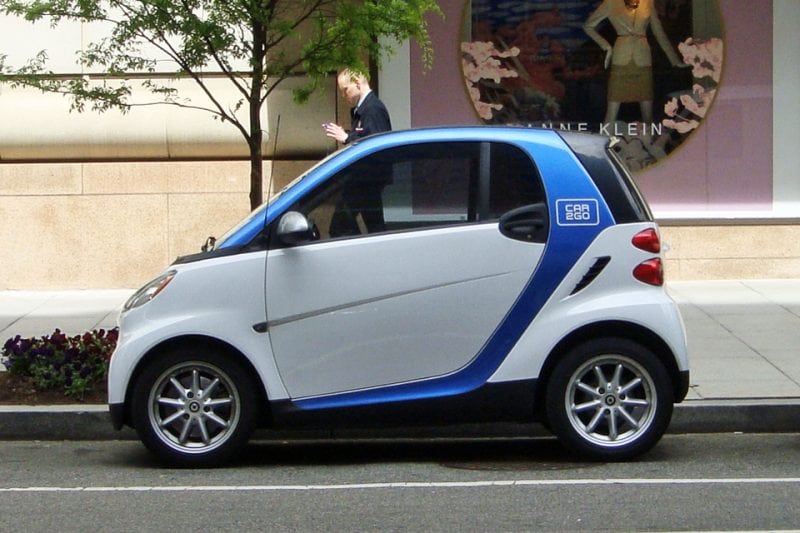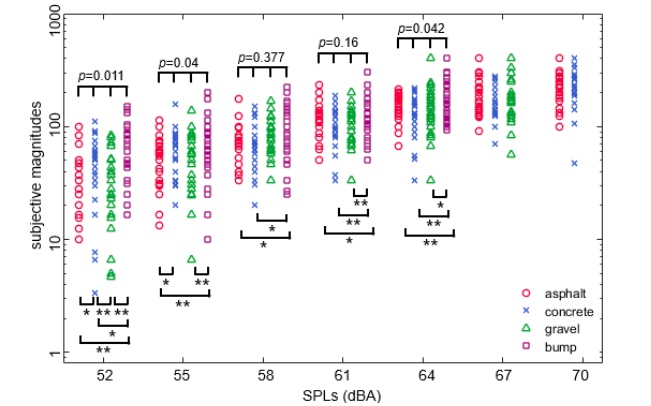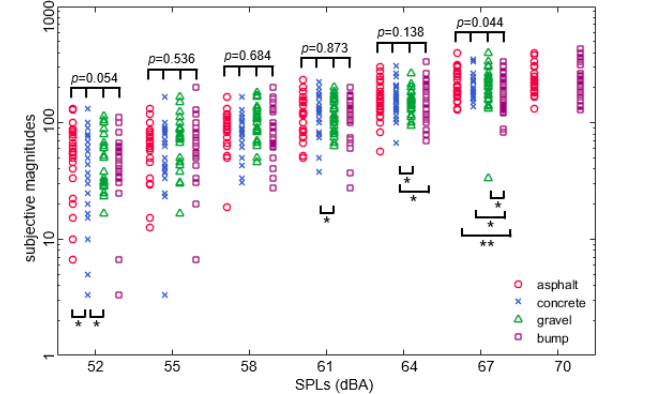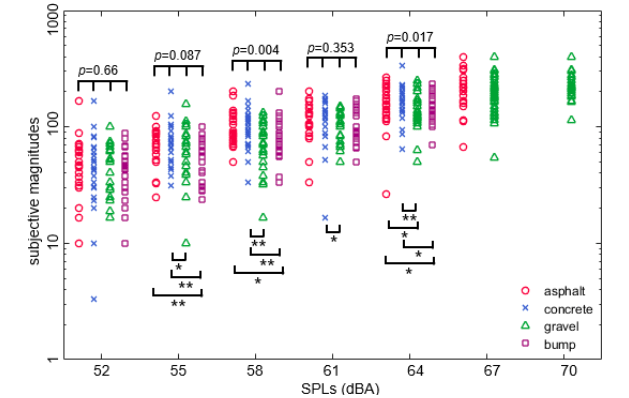
In China, micro commercial vehicles are very popular in developing areas where road conditions are complex and range from asphalt and concrete to bumpy, gravel roads. Due to consumers’ increasing demands of noise-related comfort, it is necessary to investigate the level of noise generated in various types of vehicles when they are running on various types of roads and to build a discomfort model of micro commercial vehicles’ interior noise based on sound quality analyses.
First, an artificial head recorded noise signals during a field measurement, in which 3 types of micro commercial vehicles drove on 4 types of road conditions (i.e., asphalt, concrete, gravel, and bumpy roads) at various speeds (Fig. 1). Second, 74 noise stimuli with sound pressure levels (SPL) ranging from 52 to 70 dB(A) were regenerated based on the recorded noise samples for the subjective evaluation experiment. Third, psychoacoustic parameters related to the sound quality (i.e., loudness, sharpness, roughness, and articulation index) of these stimuli were all calculated. Finally, 30 healthy subjects (15 males and 15 females) judged the subjective discomfort of the noise stimuli using the absolute magnitude estimation (AME) method [1] in a semi-anechoic chamber.

Fig.1 The field-measurement. (Image credit: Yu Huang)
The medians and inter-quartile values of the subjective magnitudes of noise discomfort classified by vehicles are shown in Fig. 2-4, including the results of statistical analyses of the influence of road conditions and vehicle types on discomfort at each sound pressure level (SPL), with the p-values of the Friedman test and Wilcoxon test (with * p<0.05, ** p<0.01). Then we analyzed the psychoacoustic characteristics related to the sound quality, i.e. loudness, sharpness, roughness, and articulation index, over 3 vehicles and 4 road conditions. Results indicated that all of the psychophysical parameters above could influence the discomfort of noise at the same SPL.

Fig. 2 The discomfort of noise generated in vehicle A and the results of Friedman test and Wilcoxon test. (Image credit: Yu Huang)

Fig. 3 The discomfort of noise generated in vehicle B and the results of Friedman test and Wilcoxon test. (Image credit: Yu Huang)

Fig. 4 The discomfort of noise generated in vehicle C and the results of Friedman test and Wilcoxon test. (Image credit: Yu Huang)
We used the multiple linear regression method to establish the relationship between the discomfort and the psychophysical parameters. There were high correlations between any 2 of the 5 variables (i.e., loudness, sharpness, roughness, articulation index and discomfort) over all SPLs (multi-collinearity phenomenon), so it might be not appropriate to determine the contribution of each psychophysical parameter on discomfort using the correlation coefficients or standardized regression coefficients.
The sample determination coefficient and partial correlation coefficient were considered when we choosing an appropriate regression equation and obtaining the contribution of each parameter on discomfort. The multiple regression equations with the sum of partial correlation coefficients close to 1 would be applicable, and the contribution of each psychophysical parameter to discomfort was determined according to the partial correlation coefficient. The regression equation of discomfort over 3 vehicles and 4 road conditions was:
DC=5.838×LD+98.213×SP-100.568, (1)
where DC is the discomfort, LD is the loudness, and SP is the sharpness. The correlation coefficient between the predicted and the measured values was 0.98 (p<0.01, Pearson).
This study established a noise discomfort model of the micro commercial vehicle based on the relationship between the subjective magnitudes and the psychophysical parameters of loudness, sharpness, roughness and articulation index. The necessary influential psychophysical parameters of discomfort, loudness, and sharpness were determined by the partial correlation analysis.
These findings are described in the article entitled “The discomfort model of the micro commercial vehicles interior noise based on the sound quality analyses,” recently published in the journal Applied Acoustics. This work was conducted by Dou Li and Yu Huang from the Institute of Vibration Shock and Noise, State Key Laboratory of Mechanical System and Vibration, School of Mechanical Engineering at Shanghai Jiao Tong University.
References
- Huang, Y. and M.J. Griffin, Comparison of absolute magnitude estimation and relative magnitude estimation for judging the subjective intensity of noise and vibration. Applied Acoustics, 2013. 77: p. 82-88.








